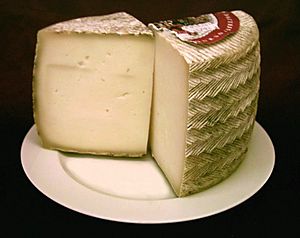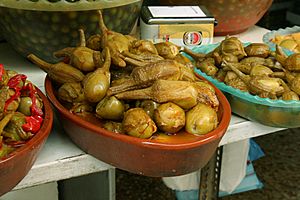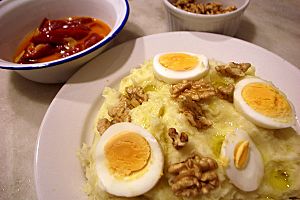Manchego cuisine facts for kids
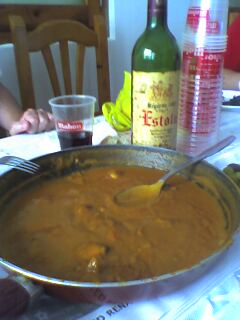
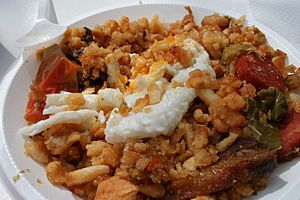

Manchego cuisine is the traditional food from the Castile-La Mancha region in Spain. This area is known for its simple, hearty dishes. These foods often use ingredients that are easy to find locally.
Many dishes are packed with energy, perfect for farmers and shepherds who work hard. The famous book Don Quixote by Miguel de Cervantes even mentions some of these traditional foods! Key items include pisto (a vegetable stew), Manchego cheese, and local wines.
Contents
Staple Foods of La Mancha
In La Mancha, some basic dishes are very old traditions. One example is gachas de almorta. This is a thick paste made from a special type of pea flour called grass pea.
Another important staple is tortas de gazpacho. These are flat breads that form the base for a more complex dish called "gazpachos." This dish was even mentioned in the Don Quixote book!
Fruits and Vegetables
Local Ingredients
A unique local plant used in cooking is the bladder campion, known as collejas. People traditionally gather these plants in the mountains of La Mancha. They are used in many different dishes.
Like much of Spanish food, many local recipes use a lot of garlic. Dishes like tiznao (salt cod with spring onions) and atascaburras (salt cod with mashed potatoes) are good examples. The ñora, a special red pepper from Valencia, is also common. It's used in dishes like manitas de cerdo (pig's feet) and migas.
A special local product is Berenjena de Almagro. These are small eggplants grown in Almagro, Ciudad Real. They are seasoned and pickled using old recipes. People usually eat them as a snack or a side dish.
Vegetarian Options
There are not many dishes in this region that are purely vegetarian. However, some traditional vegetable-based foods exist. These include pisto manchego, which is similar to ratatouille. Other options are pipirrana (a salad with onion, tomato, and cucumber) and asadillo de la Mancha (roasted red peppers). There's also gazpacho viudo, which is a type of gazpacho made with bladder campion leaves.
Meat and Fish Dishes
Many local dishes feature meat, mostly sheep and goat. Beef is used less often. Some important meat dishes are carcamusas (from Toledo), chanfarina, and roast lamb. Other popular choices include cuchifritos, migas, and gallina en pepitoria (chicken a la pepitoria).
In areas where hunting is common, game dishes are popular. These include conejo al ajillo (rabbit with garlic) and liebre a la cazadora (hare hunter-style). caldereta manchega is another well-known game dish.
La Mancha is far from the sea, so fresh fish was historically hard to get. Because of this, the traditional fish is bacalao (salt cod). This fish was brought from coastal areas and doesn't spoil easily. You can find it in dishes like chickpeas with cod, often eaten during Lent.
Manchego Cheeses
Queso manchego, or "cheese from La Mancha," is one of Spain's most famous cheeses. More than 30% of all cheese made in Spain is this type! It's a cured cheese made from the milk of local sheep. These sheep, called ovejas manchegas, graze in the pastures all year.
The cheese is quite firm and dense, with an ivory-white color. When it's new, it has a slightly tart taste from the sheep's milk. As the cheese gets older, it becomes more savory. Experts describe its flavor as a mix of buttery, tart, sweet, and nutty tastes. This cheese is also good for you, as it's high in calcium and vitamins.
There are different kinds of queso manchego. They vary based on how long they are cured. Some are even soaked in olive oil while they cure.
Wines of La Mancha
Wine making is a very important part of the region's culture and economy. Many wines from this area have special "protected designations of origin" (PDO). The main PDO is D.O. La Mancha.
Other important wine regions include D.O. Valdepeñas in Ciudad Real, and D.O. Méntrida in Toledo. There are also D.O. Jumilla and D.O. Manchuela in Albacete, and D.O. Mondéjar in Guadalajara. Besides these, many homemade wines, like "pitarras," are also enjoyed.
Main Dishes (Entrées)
- Arroz con liebre (Rice with hare)
- Atascaburras (Salt cod with mashed potatoes)
- Caldereta manchega (Manchego stew, often with game meat)
- Cuchifritos (Fried pork or lamb)
- Duelos y quebrantos (Scrambled eggs with ham and chorizo)
- Gachas (Thick flour paste)
- Migas (Fried breadcrumbs)
- Lomo a la orca (Pork loin dish)
- Patatas al ajo cabañil (Potatoes with garlic)
- Perdiz escabechada (Pickled partridge)
- Pipirrana (Vegetable salad)
- Pisto (Vegetable stew)
- Sopa de ajo (Garlic soup)
- Zarajo (Lamb intestine skewers)
Desserts
- Almendrados (Almond cookies)
- Alajú (Honey and nut cake)
- Amarguillos (Bitter almond cookies)
- Arrope (Grape syrup)
- Arroz con leche (rice pudding)
- Bienmesabe (Almond cream dessert)
- Buñuelos (Fried dough fritters)
- Copa imperial (Layered dessert)
- Dormido del corpus (Sweet bread)
- Hojuelas (Crispy fried pastries)
- Leche frita (Fried milk custard)
- Mantecados (Shortbread cookies)
- Mazapán / Mazapán de Toledo (Almond paste sweets)
- Miguelitos (Puff pastry filled with cream, from La Roda)
- Pestiños (Fried pastries with honey)
See also
 In Spanish: Gastronomía de Castilla-La Mancha para niños
In Spanish: Gastronomía de Castilla-La Mancha para niños


